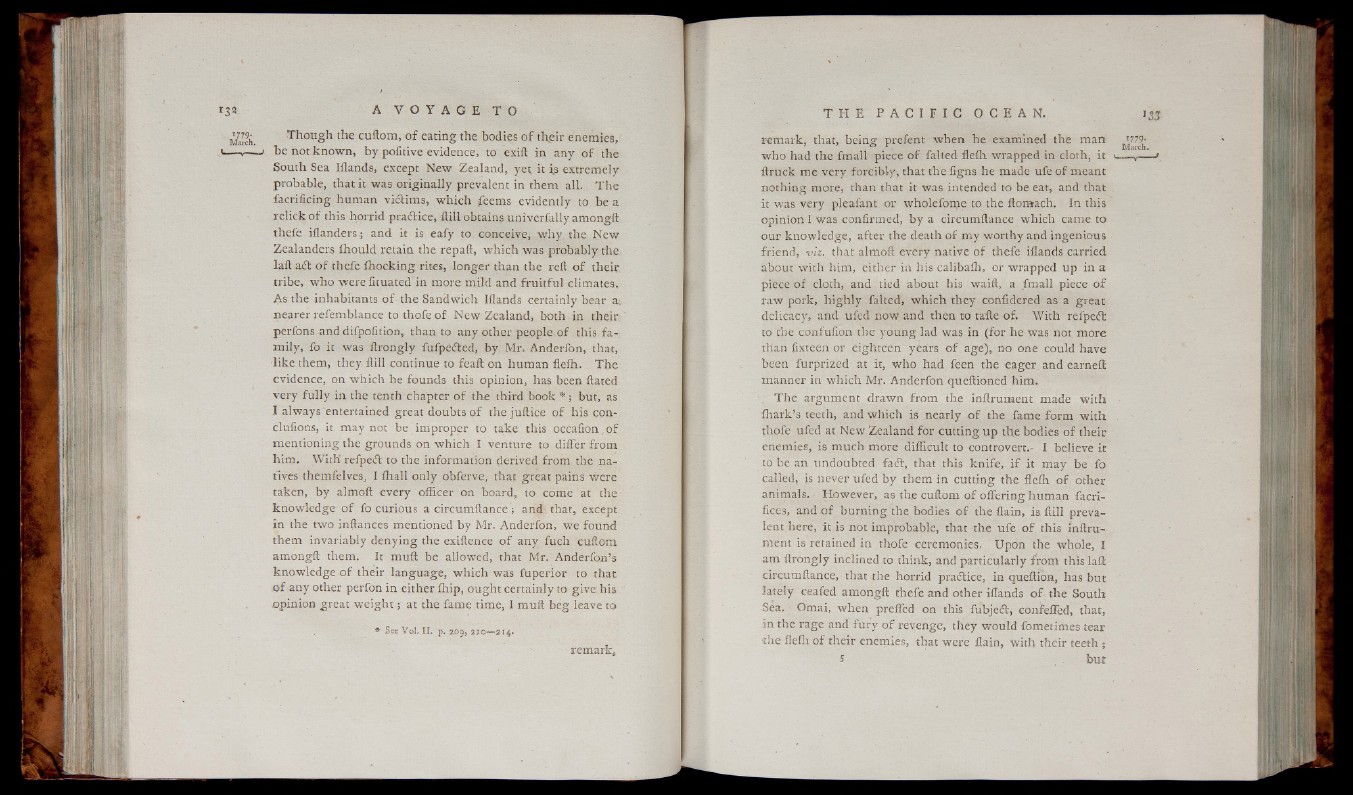
Though the cuftom, o f eating the bodies o f their enemies,
be not known, by pofitive evidence, to exift in any o f the
South Sea Iflands, except New Zealand, yet. it i.s extremely
probable, that it was originally prevalent in them all. The
facrificing human vidtims, which ¡Teems evidently to be a
relick o f this horrid pradtice, flill obtains univerfally amongft
thefe iflanders; and it is eafy to conceive, why the New
Zealanders ihould retain the repaft, which was probably the
laft a d o f thefe blocking rites, longer than the reft o f their
tribe, who were fituated in more mild and fruitful climates.
As the inhabitants o f the Sandwich Iflands certainly bear a,
nearer refemblance to thofe of New Zealand, both in their
perfons anddifpoiition, than to any other people o f this fa mily,
fo it was ftrongly fufpddted, by Mr. Anderfon, that,
like them, they ftill continue to feaft on human fleffi. The
evidence, on which he founds this opinion, has been ftated
very fully in the tenth chapter of the third book * ; but, as
I always entertained great doubts o f thejuftice o f his con-
clufions, it may not be improper to take this occafion,of
mentioning the grounds on which I venture to differ from
him. With' refped to the information derived from the natives
themfelves, I ihall only obferve, that great pains were
taken, by almoft every officer on board, to come at the
knowledge o f fo curious a circumftance; and that, except
in the two inftances mentioned by Mr. Anderfon, we found
them invariably denying the exiftence o f any fuch cuftom
amongft them. It muft be allowed, that Mr. Anderfon’s
knowledge o f their language, which was fuperior to that
o f any other perfon in either fliip, ought certainly to give his
opinion great w e ig h t ; at the fame time, I muft beg leave to
* See Vol. I I. p. 209, 210— 214.
remark,
remark, that, being prefent when he examined the man ^"79-
who had the fmall piece o f failed fleffi wrapped in cloth, it ' ,—
ftruck me very forcibly, that the figns he made ufe o f meant
nothing more, than that it was intended to be eat, and that
it was very pleafant or wholefome to the ftonaach. In this
opinion I was confirmed, by a circumftance which came to
our knowledge, after the death o f my worthy and ingenious
friend, viz. that almoft every native o f thefe iflands carried
about with him, either in his calibaffi, or wrapped up in a
piece of cloth, and tied about his waift, a fmall piece o f
raw pork, highly falted, which they confidered as a great
delicacy, and ufed now and then to tafte of. With refpedt
to the confufion the young lad was in (for he was not more
than fixteen or eighteen years o f age), no one could have
been furprized at it, who had feen the eager and earned;
manner in which Mr. Anderfon queftioned him.
. The argument drawn from the inftrument made with
ffiark’s teeth, and which is nearly o f the fame form with
thofe ufed at New Zealand for cutting up the bodies of their
enemies, is much more difficult to controvert.- I believe it
to be an undoubted fadt, that this knife, i f it may be fo
called, is never ufed by them in cutting the fleffi o f other
animals. However, as th.e cuftom o f offering human facri-
fices, and of burning the bodies o f the flain, is ftill prevalent
here, it is not improbable, that the ufe o f this inftrument
is retained in thofe ceremonies. Upon the whole, I
am ftrongly inclined to think, and particularly from this laft
circumftance, that the horrid pradtice, in queftion, has but
lately ceafed amongft thefe and other iflands o f the South
Sea. Omai, when prefled on this fubjedi, confefled, that,
in the rage and fury o f revenge, they would fometimes tear
th e -fleffi o f their enemies, that were flain, with their teeth;
i bu t